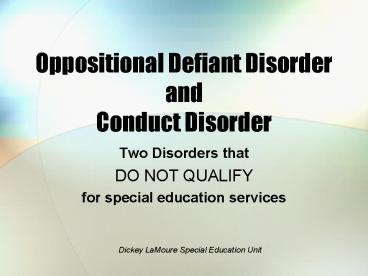Oppositional Defiant Disorder and Conduct Disorder - PowerPoint PPT Presentation
1 / 18
Title:
Oppositional Defiant Disorder and Conduct Disorder
Description:
Oppositional Defiant Disorder. and. Conduct Disorder. Two Disorders that. DO NOT QUALIFY ... Oppositional Defiant Disorder. Oppositional Defiant Disorder: ODD ... – PowerPoint PPT presentation
Number of Views:459
Avg rating:3.0/5.0
Title: Oppositional Defiant Disorder and Conduct Disorder
1
Oppositional Defiant DisorderandConduct Disorder
- Two Disorders that
- DO NOT QUALIFY
- for special education services
Dickey LaMoure Special Education Unit
2
Oppositional Defiant Disorder
3
Oppositional Defiant Disorder ODD
- An identifiable disorder that is defined in the
DSM IV as followsA pattern of negativistic,
hostile, and defiant behavior lasting at least
six months during which four or more of the
following are present--
4
Diagnostic Characteristics of ODD
- Often loses temper
- Often argues with adults
- Often actively defies or refuses to comply with
adults requests or rules - Often deliberately annoys people
- Often blames others for his or her mistakes or
misbehavior - Is often touchy or easily annoyed by others
- Is often spiteful or vindictive
5
Definition Continued
- Consider a criterion met only if the behavior
occurs more frequently than is typically observed
in individuals of comparable age and
developmental level
6
Facts about ODD
- More common in boys than girls
- Found in 16-22 of school-aged children
- Onset usually between the ages of 8 and
adolescence - Most common psychiatric problem in children.
7
Causes of ODD
- No one knows for certain.
- Usually problems begin between ages 1-3. Many of
the behaviors are normal at age 2, but they never
go away. - ODD tends to run in families.
- If a parent is alcoholic and has been in trouble
with the law, their children are 3 times as
likely to have ODD.
8
How is ODD Diagnosed?
- Examine the child
- Talk with the child
- Talk with the parents
- Review the medical history
- Run additional medical tests to rule out
something else.
9
Prognosis for children with ODD
- Some outgrow it, but it is unknown how
manyprobably the minority - ODD may turn into Conduct Disorder
- Most commonly, the child will continue to have
ODD - Children with ODD may develop mood disorders or
anxiety as they get older.
10
ODD Seldom Exists Alone
- ADHD (30-40 of the time children with ADHD will
also have ODD) - Depression and Anxiety (15-20 of children with
these conditions will have ODD)
11
Conduct Disorder
12
Conduct Disorder CD
- Severe ODD can lead to CD.
- The biggest characteristic that separates ODD
from CD is safety. - CD is the hardest pediatric neuropsychiatric
disorder to live with as a family member.
13
Definition of CD
- A repetitive and persistent pattern of behavior
in which the basic rights of others or major
society rules are violated. At least three of
the following criteria must be present in the
last 12 months, and at least one criterion must
have been present in the last 6 months
14
Diagnostic Characteristics of CD
- Aggression to people and animals
- Destruction of property
- Deceitfulness or theft
- Serious violations of rules.
15
Prognosis for Children with CD
- 30 continue with CD into adulthood
- More common in males
- Substance abuse is very high (50-70 of
10-year-olds with CD will be substance abusers
later) - 70 of children with CD show no signs as adults
- With other disorders, the CD may go away but the
other psychiatric disorders remain.
16
CD and Other Disorders
- ADHD 30-50 of children with CD have ADHD.
- Depression/Anxiety ¼ to ½ of children with CD
have either depression or anxiety. - Substance Abuse
- Learning Problems
- Bipolar Disorder
- Tourettes
17
What Can Be Done?
- Parent training programs to manage behavior
- Individual therapy to develop anger management
skills - Family therapy to improve communication
- Cognitive behavioral therapy to assist problem
solving and decrease negativity - Social skills training to increase flexibility
and improve frustration tolerance.
18
The End































